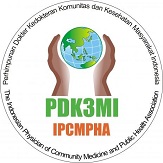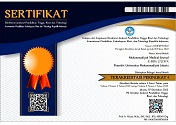Primers application with the Tso31 gene target in the molecular identification of Taenia solium
DOI:
https://doi.org/10.24853/mmj.2.1.35-40Keywords:
taeniasis, taenis solium, tso31 gene targetAbstract
Background: taeniasis is a zoonotic disease caused by Taenia spp. Human taeniasis caused by Taenia solium can be acquired after consumption of raw insufficiently cooked infected pork meat. Pigs are intermediate host for T.solium. Pigs acquired this infection by eating human feces that contained T.solium eggs. Pigs infected with T.solium can be transmitted to humans. Purposes: identification of T.solium in pig is important because it is indicator of T.solium transmission. Microscopic examination of T.solium eggs is considered less effective and efficient so that many other methods are developed for T.solium detection such as molecular and immunology. Method: This method used specific primer which can detect the Tso31 gene in T.solium. Tso31 gene is one of the most promising antigens to differentiate T.solium from T.saginata. Pig feces samples were taken by random sampling technique from 7 pig farms in Denpasar. Result: from the 30 samples, we found one sample that which gave a single amplification product of 234 bp. This indicates that the pig farms in Denpasar have been infected with T.solium. Conclusion: it is necessary to do meat inspection properly in the market as well as health education about the dangers and impacts of T.solium infection in the community.References
Ito A, Nakao M, Wandra T. Human taeniasis and cysticercosis in Asia. Lancet. 2003;362:1918–20.
Okello AL, Thomas LF. Human taeniasis : current insights into prevention and management strategies in endemic countries. Risk Manag Healthc Policy. 2017;10:107–16.
Symeonidou I, Arsenopoulos K, Tzilves D, Soba B, Gabriël S, Papadopoulos E. Human taeniasis/cysticercosis: A potentially emerging parasitic disease in europe. Ann Gastroenterol. 2018;31(4):406–12.
Aung AK, Spelman DW. Taenia solium Taeniasis and Cysticercosis in Southeast Asia. Am J Trop Med Hyg. 2016;94(5):947–54.
Ito A, Yanagida T, Nakao M. Recent advances and perspectives in molecular epidemiology of Taenia solium cysticercosis. Infect Genet Evol. 2016;40:357–67.
Montresor A, Palmer K. Taeniasis / cysticercosis trend worldwide and rationale for control. Parasitol Int. 2006;55:1–4.
Mayta H, Gilman RH, Prendergast E, Castillo JP, Tinoco YO, Garcia HH, et al. Nested PCR for specific diagnosis of Taenia solium taeniasis. J Clin Microbiol. 2008 ;46(1):286–9.
Murrell KD, Dorny P, Flisser A, Geerts S, Kyvsgaard NC, Mcmanus DP, et al. WHO / FAO / OIE Guidelines for the surveillance , prevention and control of taeniosis / cysticercosis. Murrell KD, editor. Paris; 2005.
Suriawanto N, Guli MM, Miswan. Deteksi Cacing Pita ( Taenia solium L .) melalui Uji Feses pada Masyarakat Desa Purwosari Kecamatan Torue. Biocelebes. 2014 ;8(1):17–28.
Del Brutto OH, García HH. Taenia solium Cysticercosis - The lessons of history. J Neurol Sci. 2015;359(1–2):392–5.
Qiagen. QIAamp-Fast DNA Stool Mini Kit: Quick-Start Protocol. Qiagen; 2017.
Karamon J, Sroka J, Cencek T, Różycki M, Chmurzyńska E, Zając EB, et al. Optimisation and comparison of three PCR procedures for molecular identification of Taenia solium. Bull Vet Inst Pulawy. 2013;57(12):507–12.
Morales-Gomez MA, Gárate T, Blocher J, Devleesschauwer B, Smit GS., Schmidt V, et al. Present status of laboratory diagnosis of human taeniosis / cysticercosis in Europe. Eur J Clin Microbiol Infect DIs. 2017;36:2029–40.
Vargas-calla A, Gomez-puerta LA, Lopez MT, Garcia HH, Gonzalez AE. Molecular characterization of the Taenia solium Tso31 antigen and homologous of other Taenia species from Peru. Parasitol Res. 2019;436–8.
Verastegui M, Gilman RH, Garcia HH, Gonzales AE, Arana Y, Jeri C, et al. Prevalence of Antibodies to Unique Taenia solium Oncosphere Antigens in Taeniasis and Human and Porcine Cysticercosis. Am J Trop Med Hyg. 2003;69(4):438–44.
Miguel González L, Montero E, Puente S, López-Velez R, Hernández M, Sciutto E, et al. PCR tools for the differential diagnosis of Taenia saginata and Taenia solium taeniasis/cysticercosis from different geographical locations. Diagn Microbiol Infect Dis. 2002 Apr;42(4):243–9.
Yamasaki H, Allan JC, Sato MO, Nakao M, Sako Y, Nakaya K, et al. DNA Differential Diagnosis of Taeniasis and Cysticercosis by Multiplex PCR. J Clin. 2004;42 (2):548–53.
Thanchomnang T, Tantrawatpan C, Intapan PM, Sanpool O. Rapid Molecular Identification of Human Taeniid Cestodes by Pyro-sequencing Approach. PLoS One. 2014;9(6):1–7.
Biswal D. Molecular Methods For Diagnosis of Zoonotic Helminths : Can They Be Made Accessible to the Common Man ? Adv Genet Eng. 2016;5(2):1–5.
Gilman RH, Gonzalez AE, Llanos-zavalaga F, Tsang VCW, Garcia HH, Working C. Prevention and control of Taenia solium taeniasis / cysticercosis in Peru. Pathog Glob Health. 2012;106(5):312–8.
Flisser A. State of the art of Taenia solium as compared to Taenia asiatica. Korean J Parasitol. 2013;51(1):43–9.
Gabriël S, Dorny P, Mwape KE, Trevisan C, Braae UC, Magnussen P, et al. Control of Taenia solium taeniasis/cysticercosis: The best way forward for sub-Saharan Africa? Acta Trop. 2016;165:252–60.
Bekti HS, Habibah N, Rinawati LP, Pradnya Yasa NPCD, Rindi ODG, Dewi NKAK, et al. Identifikasi Taenia solium secara Mikroskopis pada Peternakan Babi. J Kesehat. 2021 Apr;12(1):74.
Widarso H, Margono SS, Purba WH, Subahar R. Prevalensi dan distribusi taeniasis dan sistiserkosis. Makara, Kesehat. 2001;5(2):34–8.
Dharmawan NS, Swastika IK, Putra IM, Wandra T, Sutisna P, Okamoto M, et al. Present Situation and Problems of Cysticercosis in Animal in Bali and Papua. J Vet. 2012;13(2):154–62.
Downloads
Published
Issue
Section
License
Authors who publish in the Muhammadiyah Medical Journal agree to the following terms:
- Authors retain copyright and grant Muhammadiyah Medical Journal right of first publication with the work simultaneously licensed under a Creative Commons Attribution Licence that allows others to adapt (remix, transform, and build) upon the work non-commercially with an acknowledgement of the work's authorship and initial publication in Muhammadiyah Medical Journal.
- Authors are permitted to share (copy and redistribute) the journal's published version of the work non-commercially (e.g., post it to an institutional repository or publish it in a book), with an acknowledgement of its initial publication in Muhammadiyah Medical Journal.








